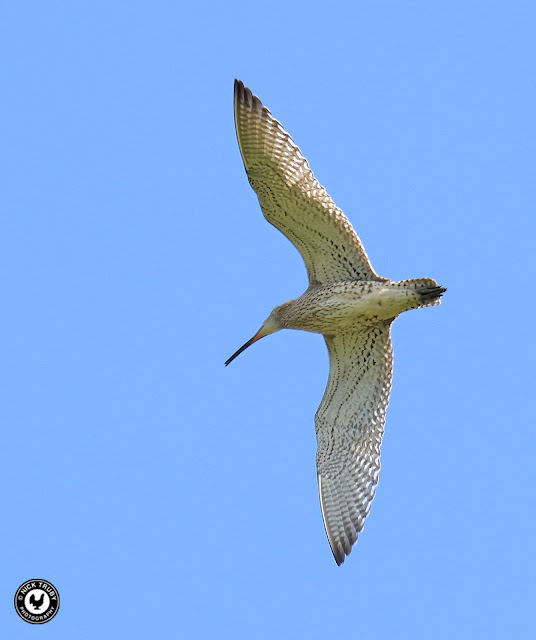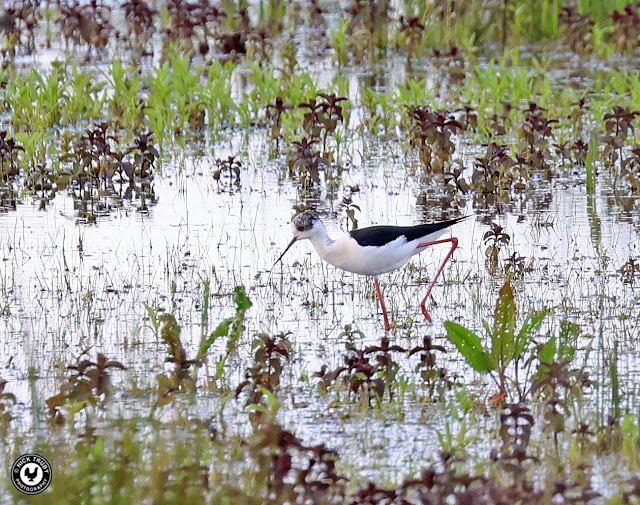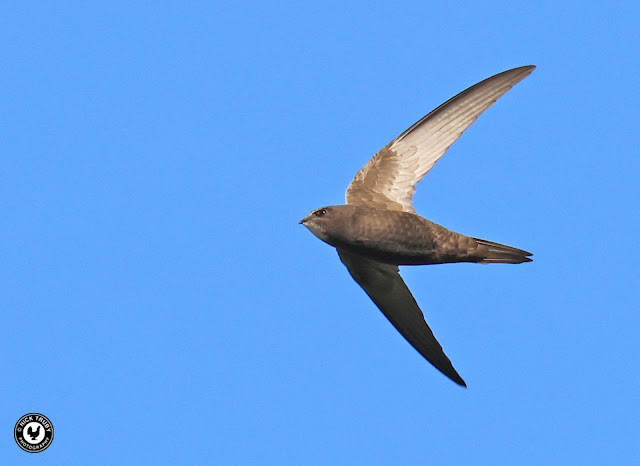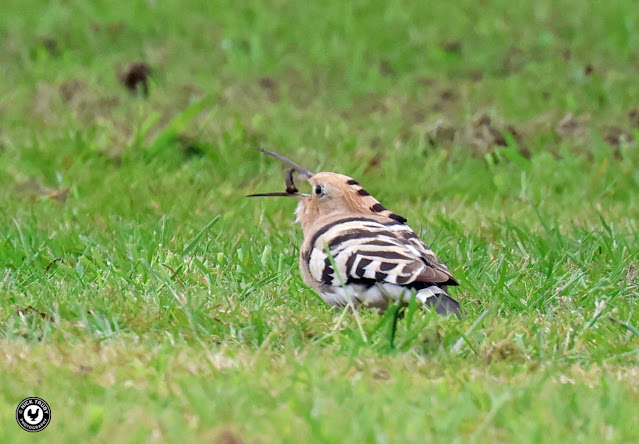Another catch-up blog in my attempt to fill in all of the days that I've not blogged, and there's been a lot of those this year. The problem with having a lot of birding days out, and having to work in between, is that time is limited to do everything else, like editing photos and writing blogs. So, for anyone interested, bear with me and enjoy the memories of warmer days!
Monday 1st May; A Wales Oakwood Delight!
Our annual visit to the RSPB reserve at Gwenfrwdd-Dinas in Mid-Wales. We've been visiting this gem of a place for over twenty years now. It's a long drive and a long day out but the Oak and Silver Birch woodlands with the fast flowing river and surrounding hills never disappoints even when it's raining, which it often is and was on this trip.
The woodlands hold special birds and you can see them within metres of leaving the carpark. In fact we saw one of those specialities before leaving the car, with a male Common Redstart singing from the top of one of the tall trees. The first birds encountered in the wood were Pied Flycatchers. There were several pairs vying for the best nesting spots. We watched a couple of males dispute territory and a female check out a nest box. There were more Common Redstarts around as well but it was still early and the grim weather lent hardly any light into the woods. I'd have to wait until either the rain cleared or it got lighter before trying to gain decent photos. Sometimes it's good to have horrible conditions because the camera is left inactive and I actually get to watch the birds at leisure.
We made our way to the Silver Birch trees that line the steep banks of the river. There we'd find my favourite of the special birds that breed here. The walk was surprisingly muddy, testament to the period of prolonged wet weather that the whole country had experienced recently, and we slithered our way there. We heard our first Wood Warbler as soon as we reached the bench. This is a great spot for seeing the brightly coloured birds owing to the fact that the path gives a level-eye view of the treetops where the Wood Warblers cavort and feed. The trilling, cascading song of the male Wood Warbler is a sheer delight and the effort that is put into singing it is to be admired. Because we'd arrived so early, we left home at four o'clock, we had the whole site to ourselves so for the next hour we were left undisturbed by anybody else. I've discovered over the years that I have the ability to whistle in a way that mimics a Wood Warbler contact calls and that draws them in towards me. Pretty soon we had one displaying and singing in the trees closest to the path.
 |
| Wood Warbler (Phylloscopus sibilatrix) |
We took an early sandwich break while sat on the wonky bench and watched a pair of Nuthatches busy about a nearby tree. Nuthatches are funky little birds, always very active and often noisy.
 |
| Nuthatch (Sitta europaea) |
Another Wood Warbler was singing on the slope behind us and provided more excellent views even if they were from underneath. In all we'd counted at least seven singing males that morning.
My photo of the day belonged to a humble Blue Tit which alighted on spindly branch framed by a blurred out green background and which would ultimately find it's way onto "The Old Caley Best Of Calendar" for the year and thus proving that birds don't have to be rare to impress.
 |
| Blue Tit (Cyanistes caeruleus) |
It's possible to take a circular walk around the reserve but there is a very tricky section by the river which entails scrambling over rocky and very uneven ground, which is not good for dodgy knees, so we returned back through the wood the same way. Pied Flycatchers appeared to be everywhere we looked, I reckoned up at least fifty in the woods. I took many photos of both sexes this time.
 |
| Pied Flycatcher (Ficedula hypoleuca) |
The Common Redstarts were much more elusive, as they quite often are, and although we could hear the males singing, they were hard to observe and our views were snatched between the branches and foliage.
 |
| Common Redstart (Phoenicurus phoenicurus) |
A brief glimpse of movement on a nearby tree alerted us to a Treecreeper. We watched as it scampered up the trunk using its curved tweezer-like bill to pry into the nooks and crannies of the bark.
 |
| Treecreeper (Certhia familiaris) |
Back at the boardwalk, the male Pied Flycatchers were very active now that the weather had slightly improved. Several birds were staking claims to territories and nesting boxes and were singing from a variety of exposed perches. Not for the first time we vowed to return to the reserve later in the summer for views of the birds feeding their offspring (and as usual would fail to do so).
Mistle and Song Thrushes were busy in the woods and we had good views of them both, foraging close to the ground and then perching while watchfully making sure we stayed just far enough away. Although we saw our first Tree Pipits of the year they were far more furtive and thwarted my best efforts with the camera.
 |
| Mistle Thrush (Turdus viscivorus) |
 |
| Song Thrush (Turdus philomelos) |
There are decent numbers of Marsh Tits in the woods and they are attracted to the feeders in the carpark as well. We found a pair actively hunting for a suitable nest hole.
 |
| Marsh Tit (Poecile palustris) |
We ended the morning as it had begun by listening to the male Redstart which was still singing from the top of the tallest trees next to the carpark. This time I grabbed a photo or two even though the rain had set in again.
Year List additions;
213) Common Redstart, 214) Pied Flycatcher, 215) Wood Warbler, 216) Tree Pipit
You can read about a fabulous eighteen hour spree in Northumberland and Fife, where no fewer than three new birds were added to our life lists here.
 |
| Grey-headed Lapwing (Vanellus cinereus) |
Year List additions;
217) Grey-headed Lapwing, 218) White-winged Scoter, 219) Stejneger's Scoter, 220) Red-necked Grebe, 221) Gannet, 222) Sandwich Tern, 223) Black Guillemot
Saturday 13th May; About Time!
There are a few birds that have somehow eluded me for far too long and that should have been seen and added to my life list ages ago. One of those species is the Iberian Chiffchaff which I'd dipped a couple of times before. There were also two Chiffchaffs that were originally thought to be Iberians but which were then demoted to mixed race birds. The year before an Iberian Chiffchaff had been present in Regents Park for several months but we had neglected to go and see it. So when a singing Iberian Chiffchaff was discovered in woodland near Polegate in Sussex, we made sure that we wouldn't make the same mistake again.
On a beautiful sunny day we pulled up in a muddy lay-by in lovely woodland and heard the singing bird as soon as we'd got out of the car. We tracked towards the song and within a few minutes had added our 409th bird to the life list. The bird was right in the highest branches of the trees so getting clear views was difficult to begin with but eventually I managed to get a few shots by backing away from the tree a short distance.
 |
| Iberian Chiffchaff (Phylloscopus ibericus) |
The bird continued to sing almost non-stop for the hour or so that we stayed. When it finally settled onto a perch more level with where we stood, for some reason I endured a total disaster with my camera which almost completely refused to focus on it. The best opportunities of getting brilliant photos are so often missed. There are gremlins at work sometimes!
It was only when the Iberian Chiffchaff turned to face away from me that the camera got its act together again. By then too late for the clincher. I spent quite a while on subsequent days out trying to work out how to get the R7 to focus when the target bird is small and against a busy background.
Year List addition;
224) Iberian Chiffchaff
Sunday 14th May; A Far Too Rare Sighting These Days
Until recently you could guarantee seeing Turtle Doves at RSPB Otmoor. Now, sadly, records of our most enigmatic Dove species have dwindled to just the occasional sighting in the county although I'm told a few hang on in places on private land. So to get a "fix" of Turtle Doves now we have to travel into Bedfordshire where a small population still survives. The plight of the Turtle Dove is one of the saddest stories in birding. The governments of countries that allow their folk to mercilessly hunt the birds should be ashamed of their (in)actions.
We found three Turtle Doves easily this time, last year it had taken us over four hours, and had ample time to watch, listen and take photos of the birds.
 |
| Turtle Dove (Streptopelia turtur) |
After bumping into our good friend Simon, who was on the same mission, we learned of a Temminck's Stint that was frequenting a gravel pit next to the new A14 carriageway at Fenstanton. Initially there was no sign of the tiny wading bird but I found it for those assembled, despite being advised to look in a totally different area because it had flown off in that direction just minutes before we arrived. Viewing was awkward, and from distance, off the raised embankment of a bridge, the extra height necessary to see over sapling trees that lined the pit.
 |
| Temminck's Stint (Calidris temminckii) |
On our way back home we detoured to check out a report of a singing Quail near Baldock. There was so sign, or sound, of it so that one would have to be added to the year list another time.
Year List additions;
225) Turtle Dove, 226) Temminck's Stint
Monday 15th May; A County Tick It!
We took a walk out onto Otmoor after work to see a long awaited county tick. A Black-winged Stilt had been found earlier on Big Otmoor and thankfully stayed for long enough for us to see it. I'd love to get a really good close view of one of the lanky and distinctive wading birds but I was more than happy to see one so close to home. My 245th species seen in Oxfordshire (although a couple of those are not strictly allowed so the official total is 243).
 |
| Black-winged Stilt (Himantopus himantopus) |
 |
| Swift (Apus apus) |
Year List addition;
227) Black-winged Stilt
Friday 19th May; Hoo(poe) Goes There?!
Every year a Hoopoe will turn up somewhere twitchable. Coventry isn't a renowned birding destination and a place that we very rarely go near but when a Hoopoe was found at New Arley, feeding on a recreation ground and in an adjacent churchyard, it made sense to go and grab it for our year list. We now had a definite ambition of completing another "Big Year" so we had to "mop up" all birds that were close enough to home. We found the Hoopoe easily and for a short while, had it to ourselves before more birders arrived. In those few minutes of solitude, I was able to stalk closer to the bird, using playground equipment as cover, and managed to get some reasonable images. Once more folk were on site the Hoopoe became much more elusive, as is often the case owing to the increased noise and movement amongst people who don't appreciate the art of good fieldcraft.
 |
| Hoopoe (Upupa epops) |
Year List addition;
228) Hoopoe
Saturday 20th May; Bogey Bird Dip!
I'm hopeless at seeing Harriers. Even the easy ones like Marsh Harriers avoid me like the plague and never come close enough for me to get any decent photos. We still hadn't connected with a Hen Harrier yet this year despite several attempts. So when a Pallid Harrier had been found in Shropshire and had shown well for most over the next couple of weeks, we geared up to add a bird that we'd only seen twice before to our year list.
The Pallid Harrier was frequenting an area of isolated high moorland near Church Stretton about twenty miles south of Shrewsbury, called the Long Mynd. We had chosen a nice sunny day to go but arrived early morning into mist which meant it was a tad chilly. We found the favoured area and met a few other hopeful birders that were also present. To cut a long and frustrating wait short, which for the most part was spent scanning the air above the moors for any raptors that may be flying, we didn't see the target Harrier. There were Buzzards, Red Kites, Kestrels, Sparrowhawks and Ravens but no Harriers, despite some other birders there claiming the Pallid when they were actually watching one of the many Buzzards. It wasn't even a pale morph.
 |
| Common Buzzard (Buteo buteo) |
We "saved" the day slightly by finding a couple of pairs of Whinchats which were new for the year. Hopefully we'll get another chance at seeing a Pallid Harrier later in the year.
 |
| Whinchat (Saxicola rubetra) |
Year List addition;
229) Whinchat
Sunday 21st May; On the Fly!
We have a spot locally where Spotted Flycatchers are virtually guaranteed. Virtually but not definitely since sadly, Spot Flys are a species in rapid decline, and I fear that soon they will become as hard as Turtle Doves are to find in Oxfordshire. The lovely sunny morning rapidly changed into a grey miserable one as it always seems to do when we bird at the quaint little church in the quintessential Oxfordshire village. It took half an hour but then without any fanfare there was a Spotted Flycatcher using the TV aerial of a cottage as a songpost. Not that I could hear it singing mind since I appear to be deaf to the high pitched song of a Spotted Flycatcher. The bird stayed for twenty seconds and disappeared.
 |
| Spotted Flycatcher (Muscicapa striata) |
Year List addition;
230) Spotted Flycatcher
Wednesday 24th May; Another Harrier Dip!
During the day a young male Montagu's Harrier had been observed quartering over Greenaways on Otmoor. Eager to see a species that I hadn't seen for over twenty years since attending an RSPB watchpoint in Lincolnshire to view a family of the Harriers, I left work as early as I could and was out on the moor by four o'clock. Naturally with my track record there was no sign of the Monty's over the next four hours.
At least we had several Hobbies to entertain us as we waited in vain.
 |
| Hobby (Falco subbuteo) |
The Montagu's Harrier was seen again the following morning.
Saturday 27th May; No Luck Again
We tried again on Otmoor on the Saturday morning in the forlorn hope that the Montagu's Harrier was still present since it had been seen twice again since we had failed to see it on the Wednesday. It wasn't around of course but we enjoyed a really good mornings birding in good company and in fine weather.
I know I shouldn't but a Red-breasted Goose that flew in with four Canada Geese was added to our year list. We saw 300 species exactly last year so we'd just have to get a few more than that this time to dispel the mutterings of the purists who would no doubt question the validity of the Goose (and a fair few more). My own thinking is that if I see a bird, feral or not, and it's living in a wild state, then it is fair game for my own year list. And I was actually rather pleased to have called the Red-breasted Goose as soon as I saw it, others had suggested Barnacle Goose. Photos proved my call was correct.
 |
| Red-breasted Goose (Branta ruficollis), centre |
Otmoor is a great place to watch and listen to Cuckoos. The males charge up and down the bridleway trying to oust their rivals from their adopted territories. Usually they manage to fly past you unseen by keeping tight to other side of the hedge that runs along The Closes, but occasionally one will stop and perch in one of the prominent Oak trees. We had some luck when one perched briefly on an exposed branch almost right above where we stood.
 |
| Cuckoo (Cuculus canorus) |
Cranes were dancing and bugling out on Greenaways and Common Terns made sorties to the shallow scrapes and ditches. Common Snipe are active at this time of year, and several were flying overhead and making that curious buzzing, known as "drumming", noise with their outer tail feathers. The Snipe were joined in the air by calling Curlews. Otmoor is at its best in May.
 |
| Common Crane (Grus grus) |
 |
| Common Tern (Sterna hirundo) |
 |
| Common Snipe (Gallinago gallinago) |
 |
| Curlew (Numenius arquata) |
I searched hard for the Harrier but it had clearly gone so after a while I concentrated for a while on some other adept fliers, Hobbies and my favourites, Swifts. With camera in hand and Swifts to point it at, then I'm a happy chap.
 |
| Swift (Apus apus) |
 |
| Hobby (Falco subbuteo) |
We heard the bubbling call of a female Cuckoo and then saw the unusual hepatic version of the bird speed past low over the reeds of the bridleway ditch. It was another male (or the same as earlier) however, that showed itself perched in an Oak again.
More Hobby photos were taken later as we stood near the bridge by the cattle pens and we had one last attempt at lucking in on the Montagu's Harrier before we brought the morning to a close.
Traffic chaos on the A34, not unusual these days, meant we detoured off through the villages where we pass a static pool of water and where we've found Curlew and Green Sandpipers before. I always stop and have a look in case a Wood Sandpiper or similar has dropped in. This time we found a fabulous Ruddy Shelduck, probably from the same school as the Red-breasted Goose. We'd already added Ruddy Shelduck to the year list with a flock of five in North Wales back in March. They were slightly less dodgy but I think we'd have to get 303 by the end of year now.
 |
| Ruddy Shelduck (Tadorna ferruginea) |
Year List addition;
231) Red-breasted Goose
Sunday 28th May; Wrong Tern
We drove to a new reserve, Harold-Odell Country Park near Northampton, where a Black Tern had been reported. We saw plenty of Common Terns but the Black Tern must have moved on. It was a pleasant morning though and we enjoyed the walk.
To make a longer day of it we ventured out to Eyebrook Reservoir which is a good place to see Ospreys fish. We had a holiday to Speyside coming up so we didn't need to go chasing the fish eating raptors but it was something to do.
 |
| Osprey (Pandion haliaetus) |
Year List addition;
232) Osprey
Monday 29th May; Full Moon Birding
Our friends Kyle and Kev had beaten us to it and gained great views, Kyle had also taken an incredible photo, of a Nightjar on Saturday evening at a Heathland area near Reading. So on Bank Holiday Monday and on a clear night and a full moon forecast we took our chance. Kyle had indicated the exact position of the tree and twig that the Nightjar had sung from so we staked it out and waited for dusk. While we sat on a convenient bench nearby we heard a quick snatch of Nightjar churring coming from a stand of silver birches but couldn't locate the bird which must have still been concealed. When Nightjar churr (the name given to the incredible whirring and weird alien-type song) they tend to choose an exposed perch so that the noise will carry to other Nightjars in the area.
Dusk approaches just after nine o'clock at this time of year but the Nightjars won't usually appear until half an hour or so later when darkness really descends. Woodcock appear earlier though, and just after the hour one came flying low across the common and sailed past very close. Woodcock also make weird sounds, a combination of strange whistles and grunts, as they fly low over the woodland and heath. If only they'd come out to play a little bit earlier when there's more light to see them in. But it is an experience to see them and to witness the weird "roding" display.
 |
| Woodcock (Scolopax rusticola) |
Twenty minutes later and the same Nightjar, the sound came from the same place anyway, was churring again. We walked along the path until we got level with the song and this time found the bird perched on outer branch of a silver birch. Only silhouetted now with the light fading fast but as always, fabulous to witness.
 |
| Nightjar (Caprimulgus europaeus) |
Another Nightjar began churring from near the seat, and I knew that this would be Kyle's bird from two days before, We hot-tailed it back down the path and then because we were so close, snuck around a tree to look where the sound was coming from. The Nightjar was perched and churring on the exact same branch as Kyle had photographed it in. We were barely thirty feet away, frightened to breathe so that we didn't disturb the bird. Thank goodness for silent mirrorless cameras too, since I was able to take photos without the Nightjar showing any concern. Listening it churr as we stood so close was really awesome!
After a few minutes the Nightjar flew off and joined another and gave us a terrific display of wind-clapping. It was now too dark for further photography unless one or both of the birds cleared the treetops. We found another churring bird in a different stand of trees so I'm pretty sure we'd seen at least four Nightjars, three males and a female.
Watching and listening to Nightjar and Woodcocks is one of the true delights of birding. The birds and the sounds they make are so weird. It's areal treat to be able to see them within an hour of home.
Year List addition;
233) Nightjar
Wednesday 31st May; A Tern-up!
Just like buses, another Black Tern turns up, four days after the one we tried for at Harold-Odell, but this time closer to home. This time one had been found at Foxcote Reservoir near Buckingham and on a chilly evening we nipped over to secure it for the year list. Last year we had seen a White-winged Tern at the same place.
The Black Tern was feeding in the sheltered bay to the left of the hide, distant but watchable. We didn't stay long because the hide had recently been partly dismantled by some helpful local youths and it was like sitting in a wind tunnel!
 |
| Black Tern (Chlidonias niger) |
234) Black Tern


















































Great photos yet again. Thank you for posting so many bird photos on your blog (here) and on FB. I learn a lot from you!
ReplyDelete